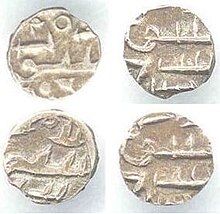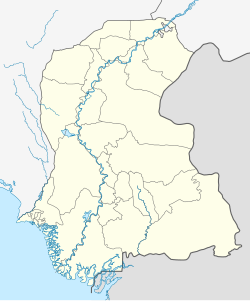This article may require cleanup to meet Wikipedia's quality standards. The specific problem is: Two articles were merged into this one. Repeated or conflicting information, if any, should be fixed. (November 2018) |
برهمڻ آباد or منصوره | |
 Coins during the rule of Amirs of Sind, c. 257 -- 421 AH / c. 870 -- 1030 AD | |
| Alternative name | Brahmanabad |
|---|---|
| Location | Sanghar District, Sindh, Pakistan |
| Coordinates | 25°52′52″N 68°46′37″E / 25.88111°N 68.77694°E |
| Type | Settlement/Capital City |
| Part of | Umayyad Caliphate and Abbasid Caliphate in Sindh |
| History | |
| Periods | Caliphal Period (Umayyad Period) (Abbasid Period) |
| Cultures | Islamic Golden Age |
Mansura (Arabic: المنصورة, romanized: al-manṣūra, lit. 'the triumphant [city]'; Sindhi: منصوره), referred to as Brahmanabad or Bahmanabad (Sindhi: برهمڻ آباد, romanized: barhamaṇabād, pronounced [ˈbəɾɦəmnɑːˈbɑːd̪]) in later centuries,[1] was the historic capital of the caliphal province of Sindh, during the eighth century under the Umayyad Caliphate and then Abbasid Caliphate[2][3] from the year 750 AD to 1006 AD. The city was founded as a central garrison by the Umayyad Forces in Sindh, the city transformed into a very vibrant metropolis during the Abbasid Era surpassing the wealth of Multan in the north and Debal in the south. Mansura was the first capital established by the Muslims in the Indian subcontinent after Muhammad bin Qasim seized the Brahmanabad territory.[4] Mansura was built on the shores of the Indus River, it was surrounded by fertile farmland, Ibn Hauqal mentioned the wealthy local merchants who wore Baghdad Costume and were of Sindhi-Arab origins, houses were made of clay, baked bricks and plaster.
Mansura exported herbs and spices, textiles, ivory, metals and mirrors to Baghdad. There were some renowned educational institutions in the city, Mansura produced the first translation of the Quran in the Sindhi language, it was used widely throughout the Indus valley region. The city was the hometown of famous historical figures such as Abu Mashar Sindhi is described by many historians and chroniclers as a pioneer in the compilation of Hadith; Abu Raja Sindhi lived in Baghdad and engaged in scientific and literary pursuits they translated a large number of ancient books of South Asia on mathematics, astronomy, astrology, medicine, literature and ethics into Arabic. According to geologists an earthquake struck both Debal and Mansura in the year 893.AD, the city was later ruled by the Soomro Emirs. Mansura was sacked by the forces of Mahmud of Ghazni because the inhabitants feared his reputation and refused to open the gates. The city never recovered and its Soomro Emirs were deposed.
The city now lies 18 kilometres (11 mi) south-east of Shahdadpur[5] and 75 kilometres (47 mi) north-east of Hyderabad.[1]
- ^ a b Wink, Al-Hind, Volume 1 1996, p. 185.
- ^ Ruins of Mansura city in Sindh Pakistan, National Geographic, 29 May 2017.
- ^ Hussain, Irshad. (1989). Mansurah - The First Capital of Muslims in Sindh. Journal of the Pakistan Historical Society 37(3): 293-303.
- ^ "SITUATIONER: Nine trenches into the past of Sindh".
- ^ Blankinship 1994, p. 335.

